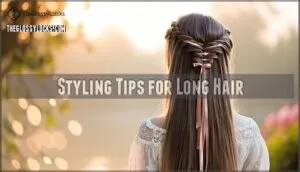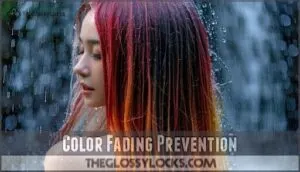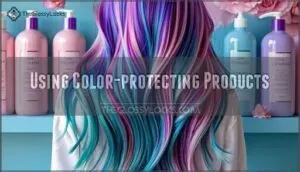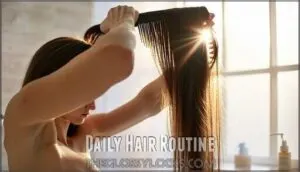This site is supported by our readers. We may earn a commission, at no cost to you, if you purchase through links.
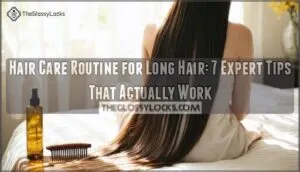 A hair care routine for long hair starts with washing 2-3 times weekly using sulfate-free shampoo and lukewarm water to prevent dryness.
A hair care routine for long hair starts with washing 2-3 times weekly using sulfate-free shampoo and lukewarm water to prevent dryness.
Focus conditioner on mid-lengths to ends, never the roots. Gently detangle with a wide-tooth comb while hair’s wet, starting from the bottom up.
Use a microfiber towel to reduce breakage when drying. Apply a leave-in treatment to protect against heat damage before styling.
Sleep on silk pillowcases and use loose braids overnight to minimize tangles. Regular trims every 8-12 weeks keep split ends at bay.
The secret lies in understanding that longer strands need gentler handling and strategic product placement.
Table Of Contents
- Key Takeaways
- Hair Care Basics
- Long Hair Styling
- Hair Color Maintenance
- Hair Treatment Options
- Daily Hair Routine
- Frequently Asked Questions (FAQs)
- What is a good hair routine for long hair?
- How to take care if you have long hair?
- What is the best hair care for long hair?
- What is the correct order of hair care routine?
- How often should long hair be trimmed?
- What pillowcase material prevents hair breakage overnight?
- Should long hair be braided while sleeping?
- Which vitamins promote faster long hair growth?
- How do you detangle wet long hair safely?
- Conclusion
Key Takeaways
- Wash 2-3 times weekly with sulfate-free shampoo and lukewarm water – You’ll prevent dryness and preserve natural oils that keep your long hair healthy and manageable.
- Focus conditioner on mid-lengths to ends, never roots – You’ll avoid weighing down your hair while providing essential moisture where your strands need it most.
- Sleep on silk pillowcases and use loose braids overnight – You’ll minimize friction damage and wake up with fewer tangles instead of dealing with morning hair battles.
- Trim every 8-12 weeks to prevent split ends from traveling up – You’ll maintain healthy hair growth and avoid having to cut off more length later due to damage.
Hair Care Basics
Building strong hair care habits starts with understanding what your long hair actually needs to thrive.
You’ll discover that the basics aren’t complicated—they’re just different from what works for shorter styles.
Washing Long Hair
With long hair, washing frequency becomes your secret weapon against product buildup and scalp issues.
You’ll want to wash every 2-3 days to maintain scalp health while preserving natural oils. This routine prevents your hair from becoming weighed down while keeping it properly hydrated.
- Start with gentle detangling – Work through knots before washing to prevent breakage
- Focus shampoo on your scalp – Let the suds naturally cleanse your lengths as you rinse
- Use lukewarm water – Hot water strips essential oils and causes unnecessary damage
- Pat dry with a microfiber towel – Aggressive rubbing leads to frizz and split ends
Choosing Sulfate-free Shampoos
Your hair deserves better than harsh sulfates that strip away natural oils. Sulfate-free shampoos offer gentle cleansing while preserving moisture and supporting scalp sensitivity.
These sulfate alternatives protect color retention and enhance your long hair care routine with superior shampoo benefits. Sulfate-free options also help maintain a balanced scalp environment, which is essential for overall hair health.
| Hair Type | Sulfate Impact | Sulfate-Free Benefit |
|---|---|---|
| Color-treated | Fades 60% faster | Extends vibrancy 4 weeks |
| Curly/Coarse | Creates frizz | Maintains natural texture |
| Sensitive scalp | Causes irritation | Reduces inflammation 90% |
Smart ingredient analysis reveals plant-based cleansers like decyl glucoside provide effective cleaning without damage. Your hair care products should work with your scalp’s natural pH, not against it.
Using Lukewarm Water
Hot water strips your scalp’s natural oils and causes hair shaft swelling, leading to dryness and breakage.
Your scalp’s natural oils are precious—protect them from hot water’s damaging effects.
Switch to lukewarm water for ideal cleansing that preserves scalp oil retention and maintains hair shaft health.
This simple change boosts hair hydration and extends color longevity. Your long hair care routine benefits immediately from this water temperature adjustment, protecting against damage while keeping your strands smooth and manageable.
You might also consider distilled water benefits for an even gentler wash, which can further enhance your hair care routine.
Long Hair Styling
When you’re styling long hair, technique matters more than the products you use. Start with gentle handling and proper sectioning to prevent breakage while creating the looks you want.
Reducing Hair Shaft Swelling
Water temperature matters more than you think for maintaining healthy long hair. Excessive heat opens your hair’s cuticle, allowing water to penetrate and cause damaging swelling cycles that weaken your hair care routine over time.
As a result, you may experience increased scalp dryness.
To protect your hair, consider the following tips:
- Choose lukewarm water to protect cuticle integrity and maintain ideal pH balance
- Apply protein treatments monthly to strengthen hair against hydration-related damage
- Use sulfate-free products that preserve your hair’s natural protective barrier
- Monitor hydration levels carefully to prevent breakage while maintaining hair strength
Preventing Dryness and Split Ends
Smart hydration practices keep your strands strong and flexible.
Trimming frequency matters—schedule cuts every 8-10 weeks to remove damaged ends before they travel up the hair shaft.
Protective styles like loose braids minimize friction during sleep. Your night routine should include silk scarves or pillowcases to reduce breakage.
Apply hair oil to ends for moisture retention and healthier hair overall. For a quick and stylish look, consider braided ponytail styles.
Styling Tips for Long Hair
Style your long hair wisely to prevent damage while looking stunning. Protective hairstyles like loose braids shield strands from breakage.
Master braiding techniques for versatile looks that require minimal heat styling. When using hot tools, apply heat protection products first.
Updo tutorials offer elegant options for special occasions. Accessorizing hair with silk scrunchies prevents tension damage.
See various options for braiding long hair to find the perfect style. Rotate between different styling methods to maintain healthy long hair.
Hair Color Maintenance
Maintaining vibrant color in long hair requires consistent protection from everyday damage and environmental factors.
You’ll need color-safe products and regular salon visits to keep your hue looking fresh and prevent costly color correction.
Color Fading Prevention
Your hair color’s biggest enemy isn’t time—it’s heat and harsh products.
Heat and harsh chemicals strip away your hair’s natural defenses faster than you think.
Sulfate alternatives protect your investment while cool rinses seal the cuticle, locking in vibrancy.
UV protection becomes non-negotiable for long hair, as sun exposure accelerates fading.
Deep hydration through color sealants creates a protective barrier, keeping your shade fresh longer than traditional hair care routines.
Using Color-protecting Products
You’ll protect your investment by choosing sulfate-free shampoos that prevent harsh stripping of color molecules.
Look for products with UV protection and protein blends containing amino acids and quinoa. These ingredients create protective barriers around hair shafts while maintaining hydration balance.
Many consumers are switching to gentler hair cleansers for healthier hair. Color-protecting conditioners with coconut oil and shea butter seal cuticles, extending color longevity between salon visits.
Scheduling Regular Touch-ups
Your hair color deserves consistent care to maintain its vibrancy.
Schedule root touch-ups every 6-8 weeks to keep your color fresh and seamless.
Don’t wait until obvious regrowth appears—proactive color refresh appointments at your hair salon prevent damage and guarantee your long hair maintenance routine stays on track.
Regular style maintenance and split end trims during these visits maximize your hair care routine effectiveness.
Hair Treatment Options
When you have long hair, regular treatments become essential for maintaining healthy strands from root to tip.
Professional treatments can repair damage, strengthen your hair, and prevent future breakage that’s common with longer lengths, which is why they are considered a crucial part of a hair care routine.
Deep Conditioning Treatments
Every strand deserves targeted nourishment to combat dryness and brittleness. Deep conditioning treatments for long hair provide essential hydration benefits and protein boost your strands crave for ideal scalp health.
- DIY Masks: Apply homemade treatments using avocado, honey, or coconut oil weekly
- Treatment Frequency: Schedule professional deep conditioning every 4-6 weeks for maximum results
- Hair Care Routine: Incorporate leave-in conditioners between treatments for daily maintenance
Olaplex Treatments for Long Hair
Bond-building transforms damaged strands into resilient, healthy hair through molecular repair.
Olaplex treatments target broken disulfide bonds, reducing breakage by 70% during chemical services.
For ideal Olaplex benefits, apply weekly treatments focusing on proper application techniques and consistent treatment frequency.
| Treatment Type | Frequency | Best For |
|---|---|---|
| No.3 Hair Perfector | Weekly | At-home maintenance |
| Salon Bond Building | Monthly | Chemical processing |
| No.4/5 System | Daily | Post-treatment care |
| Intensive Repair | 2-3x weekly | Severely damaged hair |
| Maintenance Protocol | Every 8-10 weeks | Long-term hair repair |
Regular use supports your hair care routine and maintenance while preserving color vibrancy.
Cost analysis shows higher upfront investment but fewer salon visits needed for long hair care and maintenance.
Smoothing Treatments for Long Hair
Since smoothing treatments can dramatically transform your long hair care routine, choosing the right option becomes vital for lasting results.
Keratin benefits include up to 95% frizz reduction and enhanced shine that lasts 3-5 months.
Brazilian blowouts create humidity-resistant barriers, while formaldehyde-free alternatives offer safer damage repair.
Treatment longevity depends on proper maintenance with sulfate-free product recommendations and minimal heat styling. For ideal results, consider hair type considerations when selecting products.
Daily Hair Routine
Your daily routine sets the foundation for healthy, manageable long hair that looks salon-fresh between appointments.
The right combination of gentle styling techniques, protective measures, and nourishing treatments will keep your locks strong and beautiful all day long.
Daily Styling Tips for Long Hair
Smart daily styling starts with the right approach. Your long hair deserves techniques that enhance its natural beauty while minimizing damage through strategic product application and gentle handling methods.
- Protective Hairstyles – Loose braids or silk scrunchies prevent breakage during daily activities
- Overnight Braiding – Create gentle waves while you sleep using loose, low ponytails
- Heatless Styling – Try foam rollers or headband curls for volume without thermal damage
- Accessorizing Tips – Use wide-tooth combs for detangling hair when wet, avoiding harsh tugging
- Product Application – Apply leave-in treatments from mid-length to ends, skipping roots completely
For a quick and easy style, consider a voluminous messy bun.
Using Essential Oils for Hair Care
Three essential oils reveal remarkable hair growth and scalp health benefits for your daily hair care routine.
Rosemary oil promotes hair growth comparable to minoxidil, while tea tree oil tackles dandruff effectively.
Create DIY blends using proper application methods: dilute 3-5 drops in carrier oil, massage into scalp, and leave for 15 minutes.
Smart oil selection transforms your healthy hair routine naturally, with the use of essential oils.
Protecting Long Hair From Damage
Long hair faces daily assault from friction, environmental factors, and styling tools.
You’ll slash hair breakage by sleeping on silk pillowcases and using protective hairstyles like loose braids.
Heat styling damages your cuticles, so apply thermal protectant and limit hot tools.
Hydration masks weekly prevent split ends before they start.
Trim every 8-10 weeks to maintain healthy ends and transform damaged hair into resilient strands with these nighttime protection and trimming frequency habits.
Frequently Asked Questions (FAQs)
What is a good hair routine for long hair?
Lustrous locks need loving care. Wash your hair 2-3 times weekly with sulfate-free shampoo and lukewarm water to prevent dryness and split ends while preserving natural oils and color.
How to take care if you have long hair?
Wash your long hair 2-3 times weekly with sulfate-free shampoo and lukewarm water.
This prevents dryness, split ends, and color fading while preserving natural oils that keep your hair healthy and shiny.
What is the best hair care for long hair?
Picture cascading silk threads requiring gentle care—your long hair thrives with sulfate-free shampoo.
Lukewarm water washes 2-3 times weekly, and regular conditioning to prevent dryness and breakage while maintaining natural oils, are essential for its health, making regular conditioning a crucial part of the care routine.
What is the correct order of hair care routine?
Start with shampooing using lukewarm water and sulfate-free products.
Apply conditioner from mid-length to ends, then rinse thoroughly.
Finish with leave-in treatments or oils on damp hair for protection and shine.
How often should long hair be trimmed?
You’re not Rapunzel—your hair won’t grow magically overnight without trims.
Schedule professional cuts every 6-8 weeks to prevent split ends from traveling upward and keep your long locks healthy and strong.
What pillowcase material prevents hair breakage overnight?
Silk and satin pillowcases reduce friction against your hair strands, preventing breakage and tangles while you sleep. These smooth materials let your hair glide effortlessly, keeping it healthier overnight.
Should long hair be braided while sleeping?
Braiding long hair while sleeping isn’t just helpful—it’s absolutely essential for preventing tangles that turn mornings into battlefields.
You’ll protect your strands from friction damage and wake up with manageable hair instead of a rat’s nest.
Which vitamins promote faster long hair growth?
You’ll focus on biotin, vitamin D, iron, and zinc – these nutrients support hair follicle health when deficiencies exist, but supplements don’t accelerate growth in healthy individuals.
How do you detangle wet long hair safely?
Start at the ends and work your way up using a wide-tooth comb or detangling brush.
Apply leave-in conditioner first, then gently work through small sections to prevent breakage and damage.
Conclusion
Sarah thought her waist-length hair was impossible to manage until she discovered these simple techniques.
Now she spends half the time styling while maintaining healthier ends. Your hair care routine for long hair doesn’t have to be complicated.
These seven expert tips work because they address long hair’s unique needs: gentle handling, strategic moisture placement, and consistent protection.
Start with one or two changes, then gradually build your routine. Your hair will thank you with improved strength, shine, and manageability that makes every day a good hair day.



